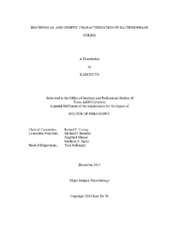| dc.description.abstract | Bacteriophages infect and kill bacterial cells. During the infection cycle, a phage attaches to the host cell surface, then ejects its DNA into the cytoplasm, where its progenies are subsequently assembled. The final step of the infection cycle is host cell lysis, which allows the progeny virions to escape into the environment. However, the timing of lysis, and thus the length of the infection cycle, is independent of endolysin biosynthesis and rather depends on the function of a second class of lysis proteins, the holins. Holins are small integral membrane proteins that accumulate harmlessly in the membrane during the infection cycle, until they suddenly form lethal lesions in the membrane at an allele-specific time. This membrane damage allows the endolysin to attack the cell wall.
This dissertation focuses on several aspects of the structural and functional aspect of holins. First, Y is the putative holin gene of the paradigm coliphage P2. Although Y is not related to the S holin of phage lambda according to its primary structure, its characterization might prove useful in discerning the essential traits for holin function. In this instance, physiological and genetic approaches are utilized to show that Y exhibits the essential holin functional criteria, namely, allele-specific delayed-onset lethality and sensitivity to the energization of the membrane. These results suggest that class I holins share a set of unique features that are needed for their remarkable ability to program the end of the phage infection cycle with precise timing. Nevertheless, I report studies involving phenotypic analysis of a systematic library of clustered site-directed mutants of S105, and then conclude with experiments designed to probe the structure of the mature “S-hole” in the membrane of the cell using chemical probes. Furthermore, I address whether the Y holin and the S21 pinholin of phage 21 effect membrane depolarization with the same all-or-nothing fashion as S while using the same tethered- cell assay previously employed for studying S. Finally, the holin and antiholin in Mu, one of the few paradigm coliphage, were identified and characterized. The introductory chapter is intended to serve as an update to the last major review on holin function in 2000. | en |


